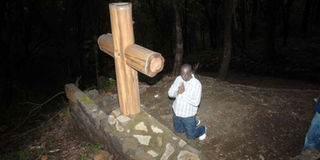Why Subukia pilgrimage site has a strong pull on tourists

A faithful says a prayer at the National Marian Shrine in Subukia, Nakuru. In Subukia there is a religious shrine called the Village of Mary Mother of God, which is also a tourist attraction. PHOTO | SULEIMAN MBATIAH | NATION MEDIA GROUP
What you need to know:
- The shrine is owned by the Kenya Episcopal Conference and managed by a Catholic order, the Franciscan Friars.
- Subukia, which is derived from the Maasai word isupuku, meaning higher grounds, is also a meeting place of two hemispheres, as the Equator runs through it.
Located in the Great Rift Valley Escarpment in Subukia is one of Kenya’s major religious sites.
Although it is meant to be a shrine for Catholic pilgrims, the Village of Mary Mother of God is also a tourist attraction.
The shrine is owned by the Kenya Episcopal Conference and managed by a Catholic order, the Franciscan Friars.
It was named the Village of Mary Mother of God in 1984 by Maurice Cardinal Otunga.
On October 3, thousands of Catholics gathered at the shrine, about 40km from Nakuru Town, for a Eucharistic Congress.
The congress brought together people from all parts of Kenya and beyond.
Subukia, which is derived from the Maasai word isupuku, meaning higher grounds, is also a meeting place of two hemispheres, as the Equator runs through it.
At the foot of the hills housing the shrine is a small chapel, where both Catholic and non-Catholic worshippers confess their sins before proceeding up the hills.
However, the walk up is not just another casual one. Along the way, there are 14 prayer stations, commonly known as ‘The Way of the Cross’.
There are prayers to recite at each station to commemorate how Jesus carried the Cross before He was crucified.
NO ENTRANCE CHARGES
The shrine is the source of a spring of cool waters believed to have healing powers.
The spring started flowing in December 1991, and has never dried up.
On the eve of the Feast of the Immaculate Conception of Mary, on December 1991, it is said that while clearing the thick bush where the shrine was to be erected, Mr Henry Muthuku, a supervisor, stumbled on a wet patch on the ground that had a small spring of water.
Many pilgrims carry containers to fetch the ‘holy’ water from the spring.
There are no entrance charges to the shrine.
At the centre of the compound is a new chapel is being constructed.
It is designed in the shape of the crown of Mary the Mother of Jesus.
It has 12 corners, symbolising the 12 stars in Mary’s crown, and 12 pillars indicating the 12 Apostles of Jesus.
Upon completion, the chapel is expected to host more than 4,500 worshippers.





